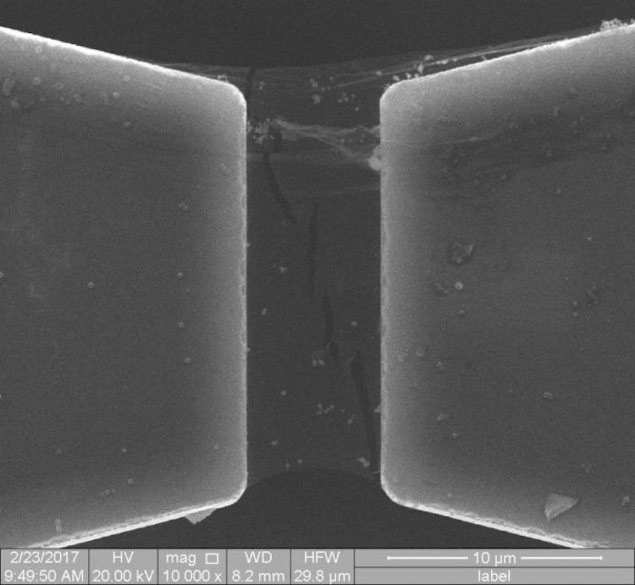
Fracture tests carried out on hexagonal boron nitride (h-BN) show that this 2D material has an intrinsic toughening mechanism, contradicting its reputation for brittleness. This unexpected behaviour, which was observed by Jun Lou, Huajian Gao and colleagues at Rice University in the US, defies a description of fracture mechanics first put forward by the British engineer A A Griffith in 1921 and still employed today to measure material toughness.
As with most materials, cracks in 2D materials typically form at sites of concentrated stress. The unique structure of 2D materials, however, means that cracks can propagate straight through, opening up the bonds between individual atoms like a zipper.
To investigate this cracking mechanism in h-BN, the Rice researchers subjected samples of single-crystal monolayers of the material to tensile loads in a micromechanical device. They found that in contrast to graphene – a one-atom-thick sheet of carbon that structurally resembles monolayer h-BN – the growth of cracks in h-BN was surprisingly stable, with cracks forming branches as the tensile load increased. This branching means that additional energy is required to drive the crack further, effectively making the material tougher, Lou explains. Overall, h-BN is 10 times more fracture-resistant than graphene, defying Griffith’s formula and leading the Rice University press office to describe it as “the iron man of 2D materials”.
Good news for flexible electronics
The atoms in both graphene and h-BN are arranged almost identically, in a flat hexagonal lattice structure. However, the researchers say that the slight asymmetries that arise in a material containing two elements (boron and nitrogen) instead of just one (carbon) may contribute to the crack branching behaviour in h-BN.

Theory and simulations reveal why propagating cracks sometimes repel each other
Regardless of the mechanism, h-BN’s newfound toughness is a boon for electronic applications. The material’s resistance to heat, stability to chemicals, and dielectric properties all make it ideal as both a supporting base and an insulating layer for placing between electronic components. The discovery that h-BN is also surprisingly tough means that it could be used to add tear resistance to flexible electronics, which Lou observes is one of the niche application areas for 2D-based materials. For flexible devices, he explains, the material needs to mechanically robust before you can bend it around something. “That h-BN is so fracture-resistant is great news for the 2D electronics community,” he adds.
The team’s findings may also point to a new way of fabricating tough mechanical metamaterials through engineered structural asymmetry. “Under extreme loading, fracture may be inevitable, but its catastrophic effects can be mitigated through structural design,” Gao says.
The researchers report their work in Nature.
